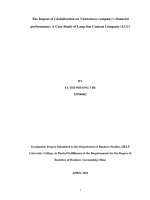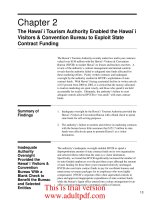Reviews of reactive, intermediate chemistry, Matthew S.Platz, Robert A.Moss, Maitland Jones
Bạn đang xem bản rút gọn của tài liệu. Xem và tải ngay bản đầy đủ của tài liệu tại đây (9.52 MB, 491 trang )
REVIEWS OF REACTIVE INTERMEDIATE
CHEMISTRY
REVIEWS OF REACTIVE
INTERMEDIATE
CHEMISTRY
Edited by
Matthew S. Platz
Department of Chemistry
Ohio State University
Columbus, OH
Robert A. Moss
Department of Chemistry
Rutgers University
New Brunswick, NJ
Maitland Jones, Jr.
Department of Chemistry
Princeton University
Princeton, NJ
Copyright © 2007 by John Wiley & Sons, Inc. All rights reserved
Published by John Wiley & Sons, Inc., Hoboken, New Jersey
Published simultaneously in Canada
No part of this publication may be reproduced, stored in a retrieval system, or transmitted in any form
or by any means, electronic, mechanical, photocopying, recording, scanning, or otherwise, except as
permitted under Section 107 or 108 of the 1976 United States Copyright Act, without either the prior
written permission of the Publisher, or authorization through payment of the appropriate per-copy fee
to the Copyright Clearance Center, Inc., 222 Rosewood Drive, Danvers, MA 01923, (978) 750-8400,
fax (978) 750-4470, or on the web at www.copyright.com. Requests to the Publisher for permission
should be addressed to the Permissions Department, John Wiley & Sons, Inc., 111 River Street,
Hoboken, NJ 07030, (201) 748-6011, fax (201) 748-6008, or online at />permission.
Limit of Liability/Disclaimer of Warranty: While the publisher and author have used their best efforts
in preparing this book, they make no representations or warranties with respect to the accuracy
or completeness of the contents of this book and specifically disclaim any implied warranties of
merchantability or fitness for a particular purpose. No warranty may be created or extended by sales
representatives or written sales materials. The advice and strategies contained herein may not be
suitable for your situation. You should consult with a professional where appropriate. Neither the
publisher nor author shall be liable for any loss of profit or any other commercial damages, including
but not limited to special, incidental, consequential, or other damages.
For general information on our other products and services or for technical support, please contact our
Customer Care Department within the United States at (800) 762-2974, outside the United States at
(317) 572-3993 or fax (317) 572-4002.
Wiley also publishes its books in a variety of electronic formats. Some content that appears in print
may not be available in electronic formats. For more information about Wiley products, visit our web
site at www.wiley.com.
Wiley Bicentennial Logo: Richard J. Pacifico
Library of Congress Cataloging in Publication Data is available.
ISBN: 978-0-471-73166-5
Printed in the United States of America
10 9 8 7 6 5 4 3 2 1
CONTENTS
PREFACE
vii
CONTRIBUTORS
ix
PART 1
1
REACTIVE INTERMEDIATES
1. Tetrahedral Intermediates Derived from Carbonyl Compounds,
Pentacoordinate Intermediates Derived from Phosphoryl and Sulfonyl
Compounds, and Concerted Paths Which Avoid Them
3
J.P. Guthrie
2. Silicon-, Germanium-, and Tin-Centered Cations, Radicals,
and Anions
47
V.Y. Lee and A. Sekiguchi
PART 2
METHODS AND APPLICATIONS
3. An Introduction to Time-Resolved Resonance Raman Spectroscopy
and Its Application to Reactive Intermediates
121
123
D.L. Phillips, W.M. Kwok, and C. Ma
4. Time-Resolved Infrared (TRIR) Studies of Organic Reactive
Intermediates
183
J.P. Toscano
5. Studies of the Thermochemical Properties of Reactive
Intermediates by Mass Spectrometric Methods
207
P.G. Wenthold
6. Reactive Intermediates in Combustion
247
J.K. Merle and C.M. Hadad
7. Reactive Intermediates in Crystals: Form and Function
271
L.M. Campos and M.A. Garcia-Garibay
v
vi
CONTENTS
8. The Chemical Reactions of DNA Damage and Degradation
333
K.S. Gates
9. Conical Intersection Species as Reactive Intermediates
379
M.J. Bearpark and M.A. Robb
10. Quantum Mechanical Tunneling in Organic Reactive
Intermediates
415
R.S. Sheridan
INDEX
465
PREFACE
In 2004, Moss, Platz and Jones edited Reactive Intermediate Chemistry. This book
contained chapters written by leading experts on the chemistry of the reactive intermediates commonly encountered in mechanistic organic chemistry; carbocations,
radicals, carbanions, singlet and triplet carbenes, nitrenes and nitrenium ions. A
three-dimensional approach was offered integrating venerable methods of chemical
analysis of reaction products, direct observational studies of reactive intermediates
(RI’s) and high accuracy calculations of the geometries, potential energy surfaces
and spectra of RI’s. The book was aimed at beginning graduate students and newcomers to a particular field to provide him or her with an introductory chapter that
would rapidly allow them to pursue advanced work.
Such is the richness and intellectual vibrancy of the field of RI chemistry that an
additional book was needed to cover silicon, germanium and tin centered RI’s, as
well as tetrahedral intermediates and topics of increasing importance such as quantum mechanical tunelling, conical intersections, solid-state chemistry, and combustion chemistry. These topics are covered in this new book.
We hope Reviews of Reactive Intermediate Chemistry well captures the continuing evolution and breadth of Reactive Intermediate Chemistry, assists chemists to
appreciate the state of the art and encourages new research in this area.
MATTHEW S. PLATZ
ROBERT A. MOSS
MAITLAND JONES, JR.
vii
CONTRIBUTORS
M. J. Bearpark
Department of Chemistry
Imperial College London
South Kensington campus
London SW7 2AZ UK
email:
L. M. Campos
University of California, Los Angeles
Department of Chemistry and
Biochemistry
607 Charles E. Young Drive East
Los Angeles, CA 90095-1569
email:
M. Garcia-Garibay
University of California, Los Angeles
Department of Chemistry and
Biochemistry
607 Charles E. Young Drive East
Los Angeles, CA 90095-1569
email:
K. S. Gates
Department of Chemistry
125 Chem Bldg.
University of Missouri
Columbia, MO 65211
email:
J. P. Guthrie
The University of Western Ontario
Department of Chemistry
London, Ontario, Canada
N6A 5B8
email:
C. M. Hadad
Department of Chemistry
Ohio State University
100 West 18th Avenue
Columbus, OH 43210
email:
W. M. Kwok
Department of Chemistry
The University of Hong Kong
Pokfulam Road
Hong Kong
email:
V. Ya. Lee
Department of Chemistry
Graduate School of Pure and Applied
Sciences
University of Tsukuba
Tsukuba, Ibaraki 305-8571, Japan
email:
C. Ma
Department of Chemistry
The University of Hong Kong
Pokfulam Road
Hong Kong
email:
ix
x
CONTRIBUTORS
J. K. Merle
National Institute of Standards
and Technology
100 Bureau Drive, Stop 8380
Gaithersburg, MD 20899-8380
email:
D. L. Phillips
Department of Chemistry
The University of Hong Kong
Pokfulam Road
Hong Kong
email:
M. A. Robb
Department of Chemistry
Imperial College London
South Kensington campus
London SW7 2AZ UK
email:
A. Sekiguchi
Department of Chemistry
Graduate School of Pure and Applied
Sciences
University of Tsukuba
Tsukuba, Ibaraki 305-8571, Japan
email:
R. S. Sheridan
Department of Chemistry/216
University of Nevada, Reno
Reno, NV 89557
email:
J. P. Toscano
Department of Chemistry
Johns Hopkins University
3400 N. Charles Street
Baltimore, MD 21218
email:
P. G. Wenthold
Department of Chemistry
Purdue University
560 Oval Drive
West Lafayette, Indiana, 47907-2084
email:
PART 1
REACTIVE INTERMEDIATES
CHAPTER 1
Tetrahedral Intermediates Derived
from Carbonyl Compounds,
Pentacoordinate Intermediates
Derived from Phosphoryl and Sulfonyl
Compounds, and Concerted Paths
Which Avoid Them
J. PETER GUTHRIE
Department of Chemistry, University of Western Ontario, London, Ontario, Canada N6A 5B7
1.1. Tetrahedral Intermediates
1.1.1. Evidence for Tetrahedral Species as Reactive Intermediates
1.1.2. Stable Analogs
1.1.3. Special Cases
1.1.4. Equilibrium Constants
1.1.5. Indirect Equilibrium Constants
1.1.6. Equations for the Effect of R, RЈ
1.1.7. Equations for the Effect of Nu
1.1.8. Anomeric Effect
1.1.9. Estimation of Equilibrium Constants for Tetrahedral Intermediate Formation
1.1.10. Mechanisms of Tetrahedral Intermediate Formation and Breakdown
1.1.11. Rates of Breakdown of Tetrahedral Intermediates
1.2. Pentacoordinate Intermediates Involving P
1.2.1. Bonding in Pentacoordinate Phosphorous and Sulfur Compounds
1.2.2. Indirect Equilibrium Constants
1.3. Pentacoordinate Intermediates Involving S
1.4. Concerted Reactions
1.4.1. General Principles
1.4.2. Evidence for Concerted Reactions
1.4.3. Possible Concerted Reactions of Phosphate Esters
4
5
8
8
10
11
12
12
13
13
17
19
21
22
23
23
24
24
26
36
Reviews of Reactive Intermediate Chemistry. Edited by Matthew S. Platz, Robert A. Moss,
Maitland Jones, Jr.
Copyright © 2007 John Wiley & Sons, Inc.
3
4
TETRAHEDRAL INTERMEDIATES DERIVED FROM CARBONYL COMPOUNDS
1.5. Conclusion and Outlook
Suggested Reading
Appendix: The Method of Branch and Calvin
References
39
40
40
42
1.1. TETRAHEDRAL INTERMEDIATES
This chapter will deal mainly with tetrahedral intermediates from carbonyl derivatives, with some discussion on the much less-studied analogs for phosphorus and
sulfur. It will also address the issue of concerted mechanisms which can sometimes
bypass these intermediates.
Carbonyl reactions are extremely important in chemistry and biochemistry, yet they
are often given short shrift in textbooks on physical organic chemistry, partly because
the subject was historically developed by the study of nucleophilic substitution at saturated carbon, and partly because carbonyl reactions are often more difficult to study.
They are generally reversible under usual conditions and involve complicated multistep
mechanisms and general acid/base catalysis. In thinking about carbonyl reactions, I
find it helpful to consider the carbonyl group as a (very) stabilized carbenium ion, with
an OϪ substituent. Then one can immediately draw on everything one has learned about
carbenium ion reactivity and see that the reactivity order for carbonyl compounds:
CH2ϭO Ͼ CH3CHϭO Ͼ PhCHϭO Ͼ (CH3)2CϭO Ͼ CH3COPh
corresponds almost perfectly to the order for carbenium ions (see Table 1.1).
CH3CH2ϩ Ͼ (CH3)2CHϩ Ͼ Ph(CH3)CHϩ ϳ (CH3)3Cϩ Ͼ (CH3)2 (Ph)Cϩ
The difference between carbonyl chemistry and (simple) carbocation chemistry is
a result of much greater stability of the carbonyl group relative to a simple carbenium
TABLE 1.1. Reactivity of carbonyl compounds and carbenium ions. a
pKRϩ
log KH2Of
a
CH3CH2ϩ
(CH3) 2CHϩ
Ph(CH3)CHϩ
(CH3)3Cϩ
(CH3) 2 (Ph)Cϩ
Ϫ29.6b
CH2ϭO
1.61
Ϫ22.7b
CH3CHϭO
Ϫ1.72
Ϫ16.2c
PhCHϭO
Ϫ3.82
Ϫ16.4d
(CH3) 2CϭO
Ϫ4.60
Ϫ13.1e
CH3COPh
Ϫ6.92
All in aqueous solution at 25ЊC; standard states are 1M ideal aqueous solution with an infinitely dilute
reference state, and for water the pure liquid.
b
Reference 1.
c
Reference 2.
d
Reference 3.
e
Reference 4.
f
Reference 5.
TETRAHEDRAL INTERMEDIATES
5
ion. This means that for many carbonyl group/nucleophile combinations the carbonyl compound is more stable than the adduct, which is not the case for what are
traditionally considered carbenium ions until one gets to stabilized triaryl cations
(e.g., crystal violet) or to very non-nucleophilic solvents such as magic acid.6
Thus carbonyl chemistry can be considered as analogous to SN1 chemistry and is
in fact inherently faster than SN2 chemistry (not that SN2 reactions cannot be fast, but
this requires a strong thermodynamic driving force: for a comparable driving force
the carbonyl reaction is faster).
The big difference is that for simple carbenium ions the cation is a transient intermediate and the covalent adduct is the normally encountered form, while for carbonyl compounds the “carbenium ion” is the stable form (with a few exceptions) and
the covalent adduct is the transient intermediate. In fact, in many cases, the tetrahedral intermediate is too unstable to be detected (at least with current techniques)
and yet the rate of overall reaction is strongly influenced by the height of this thermodynamic barrier. By Hammond’s Postulate, a reaction leading to a high energy
intermediate will have a transition state resembling this intermediate in structure
and energy. If we can estimate the energy of the intermediate, then we have taken
the first step toward estimating the rate of reaction.
For many carbonyl reactions, attempts have been made to prepare catalytic
antibodies which accelerate the reaction. Such antibodies are normally obtained
by challenging the immune system of a suitable animal with a compound resembling the tetrahedral intermediate in the reaction of interest. The idea is
that if the antibody binds to and thus stabilizes the tetrahedral intermediate it
will facilitate the reaction.7,8 If the intermediate is a tetrahedral intermediate
based on carbon then the analog is often a phosphate or phosphonate derivative,
which is a stable tetrahedral species with a geometry and surface charge distribution resembling those of the intermediate in the reaction to be catalyzed.9
A complimentary idea is that anything which resembles the transition state for
an enzyme-catalyzed reaction, but is unreactive, will be a very strong inhibitor
of that reaction.10,11 Thus mimics of the tetrahedral intermediate can be strong
inhibitors of enzymes catalyzing reactions which proceed by way of reactive
tetrahedral intermediates.
1.1.1. Evidence for Tetrahedral Species as Reactive Intermediates
As early as 1899, Stieglitz12 proposed a tetrahedral intermediate for the hydrolysis
of an imino ether to an amide. Thus it was clear quite early that a complicated
overall transformation, imino ether to amide, would make more sense as the result
of a series of simple steps. The detailed mechanism proposed, although reasonable
in terms of what was known and believed at the time, would no longer be accepted,
but the idea of tetrahedral intermediates was clearly in the air. Stieglitz stated of
the aminolysis of an ester that “it is now commonly supposed that the reaction
takes place with the formation of an intermediate product as follows:” referring to
work of Lossen.13 (Note that the favored tautomer of a hydroxamic acid was as yet
unknown.)
6
C6H5
TETRAHEDRAL INTERMEDIATES DERIVED FROM CARBONYL COMPOUNDS
C
OH
O
OC2H5
+ NH2OH
C6H5
C NHOH
C6H5
C
OC2H5
OH
NOH
+ C2H5OH
For many reactions of aldehydes or ketones with nucleophiles, the tetrahedral adduct is more or less readily detectable. Formaldehyde is overwhelmingly converted
to methylenediol in water,14 acetaldehyde is about 50% hydrated in water,15 and acetone is only slightly converted to the hydrate, although the hydrate is readily detected
by modern NMR instruments (the signal for the hydrate CH3 is somewhat smaller
than that for the 13C satellite for the CH3 of the keto form).16 Thus, it is reasonable to
assume that all carbonyl compounds can undergo nucleophilic addition, even when it
is not directly detectable. For functional groups such as esters, the adduct with water
or alcohol or even alkoxide is, for normal esters, at such low concentrations as to be
undetectable. However, electron-withdrawing groups favor the addition of nucleophiles, so that CF3COOMe will add MeOϪ17,18 and the equilibrium constant in methanol can be determined by 19F NMR titration; at high concentrations of methoxide
the conversion is essentially complete.19
A more difficult challenge is to establish that a tetrahedral intermediate is on
the reaction path for the transformation of a carbonyl containing functional group.
Isotopic exchange occurring with rates and a rate law very similar to hydrolysis provides strong evidence that the tetrahedral intermediate is on the reaction path and
is partitioning between proceeding on to product or reverting to starting material
with the loss of isotope.20 This simple interpretation assumes that proton transfers
involving the tetrahedral intermediate are fast relative to breakdown, which need not
always be true.21
R C OEt
+
HO
R C OEt
OH
R C
+ EtOH
O
H
O
R C OEt + H
R C OEt
O
+ HO
OH
R C OEt
O
R C
O
+ EtOH
O
In other ester reactions, there may be concern that the reaction might be concerted, bypassing the tetrahedral intermediate. We will return to this question
later. If the properties of Nu: or Lv: can be varied so that the relative leaving group
TETRAHEDRAL INTERMEDIATES
7
abilities within the tetrahedral intermediate change from “Lv:” being poorer than
“Nu:” to “Lv:” being better than “Nu:” (allowing where necessary for any other
factors which influence relative leaving group ability), then there will be a change
in rate determining step if the mechanism is stepwise by way of a tetrahedral intermediate. This will show up as a break in a linear free energy relation (whether
Hammett, or Taft, or Brønsted plot) for the stepwise mechanism, but as a simple
linear relationship for the concerted mechanism 22 (see below). This test requires
that the two competing steps of the stepwise reaction (breakdown of the intermediate to starting material or to product) have sufficiently different slopes for the linear free energy relation to give a clear break. This need not be the case if both are
fast; that is, if the intermediate is of relatively high energy, so that by Hammond’s
Postulate the two transition states are close to the structure of the intermediate
(and necessarily also to each other) and thus respond similarly to changes in reactant structure.
stepwise
O
Lv + Nu:
R
O
k1
R
k–1
O
k2
Lv
R
Nu
+ Lv:
Nu
concerted
R
π
O
O
Lv + Nu:
R
Lv
O
R
Nu
+ Lv:
Nu
If the formation and breakdown steps of a mechanism involving a tetrahedral
intermediate respond differently to changes in pH or catalyst concentration, then
one can find evidence from plots of rate versus pH or rate versus catalyst concentration for a change in rate determining step and thus for a multistep mechanism. An
example would be the maximum seen in the pH rate profile for the formation of an
imine from a weakly basic amine (such as hydroxylamine).23 On the alkaline side
of the maximum, the rate determining step is the acid-catalyzed dehydration of the
preformed carbinolamine; on the acid side of the maximum, the rate determining
step is the uncatalyzed addition of the amine to form the carbinolamine. The rate
decreases on the acid side of the maximum because more and more of the amine is
protonated and unable to react.
If some change in reaction conditions leads to a change in the products of a reaction, without changing the observed rate, then there must be an intermediate which
partitions in ways which respond to these changed reaction conditions, and formation of the intermediate must be rate determining. For instance, the products from
the hydrolysis of the iminolactone shown below change with changing pH over a
range where there is no change in the observed rate law.24
8
TETRAHEDRAL INTERMEDIATES DERIVED FROM CARBONYL COMPOUNDS
NH
O
H2O
NH2
O
NH2 O
O
O
favored below pH 7
slow
NH OH
O
NH
O
OH
favored above pH 7
1.1.2. Stable Analogs
It is worth noting that the reactivity and short lifetime of most tetrahedral intermediates are a consequence of the presence of several electronegative atoms on a single
center, with at least one of these atoms bearing a hydrogen. This means that an elimination pathway is accessible, which leads to a neutral product that is likely to be more
stable than the tetrahedral intermediate. Without at least one electronegative atom
bearing a hydrogen, any elimination must lead to a cationic species, which in most
cases provides an additional barrier to reaction. Such analogs of tetrahedral intermediates are in fact well-known materials, acetals, aminals, orthoesters, and so forth and
are relatively stable (compared with tetrahedral intermediates) because they do not
have a facile elimination pathway. They are nonetheless reactive, especially to acid
or, in some cases, simply exposure to polar solvents.25 Mixed orthoacid derivatives
[acetals of amides, R-C(ORЈ)2 (NRЉ2), monothioorthoesters, R-C(ORЈ)2 (SRЉ), and
even mixed orthoesters, R-C(ORЈ)2 (ORЉ)] are also prone to disproportionation, especially in the presence of even traces of acid.26 Thus HC(OEt)2 (OR), Rϭcyclohexyl,
becomes a mixture of HC(OEt)3, HC(OEt)2 (OR), HC(OEt)(OR)2, and HC(OR)3.26
Monothioorthoesters have a distinct tendency to go to mixtures of orthoesters and
trithioorthoesters: HC(OEt)2 (SEt) goes to HC(OEt)3 and HC(SEt)3.26
1.1.3. Special Cases
There are some special cases where tetrahedral intermediates are unusually stable;
there are three phenomena which lead to this stability enhancement. The first is an
unusually reactive carbonyl (or imine) compound which is very prone to addition. An
example of such a compound is trichoroacetaldehyde or chloral, for which the covalent hydrate can be isolated. A simple way to recognize such compounds is to think
of the carbonyl group as a (very) stabilized carbocation, bearing an OϪ substituent.
TETRAHEDRAL INTERMEDIATES
9
Groups which would destabilize a carbocation (H, or an electron-withdrawing group)
will make the carbonyl more reactive to addition, both kinetically and thermodynamically. Formaldehyde is a peculiar case, because it is overwhelmingly converted
to methylenediol in water, but upon evaporation it breaks down to gaseous formaldehyde rather than remaining as the liquid diol. It can (with acid catalysis) be trapped
either as paraformaldehyde or trioxane. Similarly, hexafluoroacetone hydrate is a
liquid, with useful solvent properties and little tendency to lose water.27 CF3 groups
are even more destabilizing to an adjacent Cϩ than H. The same reasoning explains
why one can titrate methyl trifluoroacetate with methoxide in dry methanol, observing formation of the anionic tetrahedral species by 19F NMR.19
The second special case is addition of a very good nucleophile; hydrogen cyanide
and bisulfite are the most common examples, and cyanohydrins, α-cyanoamines and
bisulfite adducts (α-hydroxy sulfonates) are commonly stable enough to isolate, at
least for reactive carbonyl compounds. All these compounds are prone to fall apart
under suitable conditions, regenerating the carbonyl compound.
The third phenomenon which favors tetrahedral intermediates is intramolecularity, and if a nucleophile is contained in the same molecule as a carbonyl group, it
will show an enhanced tendency to add; the less entropy is lost in this addition (the
fewer free rotations must be frozen out) the more the addition is favored. A famous
example of this phenomenon is tetrodotoxin (1), the toxin of the puffer fish.28 This
molecule is a hemiorthoester in which there is an OϪ on a carbon atom which also
has two alkoxy groups, yet it does not break down to give a lactone. The explanation
is that a secondary alcohol is held very close to the lactone carbonyl and thus there is
an entropic advantage to the addition relative to a corresponding intermolecular reaction. In addition, there are numerous electron-withdrawing groups which enhance
the reactivity of the lactone carbonyl toward addition.
OH
HO
HO
HN
H2N
N
H
HO
OO
O
H
HO
1
A more recent example is the twisted amide (2) devised by Kirby,29 which despite
the lack of electron-withdrawing groups (other than nitrogen) is completely hydrated
upon protonation on nitrogen; here the “amide” is unable to delocalize the nitrogen electrons onto the carbonyl, which means there is none of the usual amide stabilization.
H
N
H3C
O
CH3
N
H , H2O
H3C
H3C
H3C
2
OH
OH
CH3
10
TETRAHEDRAL INTERMEDIATES DERIVED FROM CARBONYL COMPOUNDS
TABLE 1.2. Equilibrium constants for addition of nucleophiles to carbonyl compounds. a
Nucleophile/
Carbonyl
compound
RSH b
RNH2c
H 2O
HOMe
CH2O
CH3CHO
(CH3) 2CHCHO
(CH3)3CCHO
PhCHO
41e
0.019e
0.011e
4.2 ϫ 10Ϫ3e
1.5 ϫ 10Ϫ4r
4-pyridine-CHO
4Cl-Ph-CHO
4-NO2-Ph-CHO
CH3COCH3
Ph-CO-CH3
Ph-CO-CF3
HCOOCH3
1310 e
0.741e
0.360 e
0.128e
3.6 ϫ 10Ϫ3s
0.09t
0.50w
0.24t
3.0t
2.2 ϫ 10Ϫ4e
0.023w
193h, g
87w
4.0 ϫ 10Ϫ4 r
2.3h, g
3.1 ϫ 10Ϫ3 r
2.5 ϫ 10Ϫ5e
1.2 ϫ 10Ϫ7 y
1.40cc
100dd, ee
3 ϫ 10Ϫ7 ff
8 ϫ 10Ϫ8 s
6 ϫ 10Ϫ9ff
9 ϫ 10Ϫ11s
0.1ff
3 ϫ 10Ϫ4 ff
6 ϫ 10Ϫ9 ff
8 ϫ 10Ϫ7 s
2 ϫ 10Ϫ3 ff
2 ϫ 10Ϫ14 ff 8 ϫ 10Ϫ13 s
1 ϫ 10Ϫ12 s
6 ϫ 10Ϫ15 ff 2 ϫ 10Ϫ14 s 1.1 ϫ 10Ϫ12 s
3 ϫ 10Ϫ14s
5 ϫ 10Ϫ9 s
5 ϫ 10Ϫ14 s 2 ϫ 10Ϫ14s
CH3COOCH3
CF3COOCH3
HCOSCH2CH3
CH3COSCH2CH3
CF3COSCH2CH3
HCON(CH3) 2
CH3CON(CH3) 2
CF3CON(CH3) 2
PhCON(CH3) 2
R 2NHd
1.4 ϫ 106 f,g 3.4 ϫ 106h 2.6 ϫ 106i
36.k,l
–
61.s
16p
8.5m
1.7n
4.8p,q
1.5s
NH2OH
HCN
HSO3Ϫ
–
–
–
9.18 ϫ 108e 6.6 ϫ 109j
3.7 ϫ 10 4e 6.8 ϫ 105o
–
4.8 ϫ 10 4j
11.3u
236v
6.4 ϫ 103 e
3.0 ϫ 102 h
1820v
14e
0.77z,aa
760dd
1.1 ϫ 10 4h
1500h
24h
153x
1.0u
1.5 ϫ 103dd
230 e
5.5bb
2.3 ϫ 103dd
4 ϫ 10Ϫ5 s
1 ϫ 10Ϫ8 s
1 ϫ 10Ϫ4 s
a
All in aqueous solution at 25ЊC unless otherwise noted; equilibrium constants have dimensions of
b
c
MϪ1.
Various alkane thiols, of similar equilibrium reactivity.
Methylamine or a primary
d
alkyl amine of similar reactivity.
Dimethylamine or a secondary alkyl amine of similar reactivie
f
g
h
i
ty
Reference 30.
Reference 14.
RSH is mercaptoethanol.
Reference 31.
Reference
j
k
l
m
n
32.
Reference 33.
Reference 21.
RSH is ethanethiol
Reference 34.
Reference
o
p
q
r
s
35.
Reference 36.
Reference 37.
RSH is 2-methoxyethanethiol.
Reference 38.
Reft
u
v
w
x
erence 39.
Reference 40.
Reference 23.
Reference 41.
Reference 31.
Refery
z
aa
bb
cc
ence 42.
Reference 5.
Reference 43.
In ethanol.
Reference 44.
Reference
dd
ee
ff
45.
Reference 46.
RNH 2 is n-butylamine.
Reference 47.
1.1.4. Equilibrium Constants
Table 1.2 gives a representative sampling of equilibrium constants for additions to
various types of carbonyl compounds. Notice that there are numerous gaps in the
table. This means that much remains to be done in the study of carbonyl addition reactions. In trying to devise schemes for predicting the equilibrium constants for such
reactions, the scarcity of experimental data is a serious handicap. There are many
fewer equilibrium constants for additions to imines, and even fewer cases where
TETRAHEDRAL INTERMEDIATES
11
TABLE 1.3 Equilibrium constants for addition to imines.a
Imine/
nucleophile
Ph-CHϭNCH2Ph
HCN
n-BuSH
MeOH
8.1 ϫ 103 b,c
Ph-CHϭN-Ph
4-NO2-PhCHϭN-Ph
4-NO2-Ph-CHϭNPh-4-OCH3
5.21d
1.5 ϫ 10Ϫ3 e
2.0 ϫ 10Ϫ3 f
27.5d
7.1 ϫ 10Ϫ3 e
8.1 ϫ 10Ϫ3f
0.6 ϫ 10Ϫ3e
a
In methanol at 25ЊC unless otherwise noted; equilibrium constants have dimensions MϪ1.
Reference 48.
c
In aqueous solution.
d
Reference 49.
e
Reference 50.
f
Reference 51.
b
there is any kind of systematic set. Table 1.3 gives some representative values. There
are also a few equilibrium constants for the addition of water to imines, but these do
not overlap with the other additions.
1.1.5. Indirect Equilibrium Constants
For many addition reactions of carbonyl compounds, it is not possible to measure
equilibrium constants directly because they are too unfavorable, and there is no selectively sensitive assay for the adduct. Two indirect methods allowing calculation
of these equilibrium constants have been reported. The first takes advantage of the
existence, for many unstable tetrahedral adducts, of orthoester analogs, which are
stable because there are no OH (or NH or SH) groups in the analog, where they are
present in the adduct of interest. If one can prepare and purify the analog, then its
heat of hydrolysis can be measured, its solubility can be measured or estimated, and
its entropy can be estimated by standard methods. This means that the free energy
of formation of the analog can in principle be determined. Then one needs only to
calculate the equilibrium constant for the hypothetical hydrolysis which converts the
orthoester analog into the tetrahedral adduct,30 to be able to calculate the free energy of formation of the adduct. From this, plus the free energies of formation of the
carbonyl compound and the nucleophile, one can calculate the equilibrium constant
for the addition reaction. The nice thing about the hypothetical hydrolysis is that one
can say with confidence that its free energy change will be small. This must be so
because in this hydrolysis the number of OH and CO bonds is conserved (so that by
the bond energy additivity approximation ∆H will be zero), and the number of molecules is the same before and after the reaction (so that to a first approximation ∆S
will be zero). The free energy change does depend on symmetry (the number of OR
groups on the LHS), on steric interactions (OH is smaller than OR and thus will have
smaller steric interactions), and on electronic effects (there is a small dependence on
σ* for the R1,R2, R3 groups). This method has been applied to esters,52 amides,53 and
12
TETRAHEDRAL INTERMEDIATES DERIVED FROM CARBONYL COMPOUNDS
thioesters.47 Various values determined by this approach are included in the tables
in this chapter.
R1
R2 C OR
R3
+ H2O
R1
R2 C OH + HOR
R3
A quite different and complimentary approach is to assume that addition of a
nucleophile to an acyl derivative (RCOX) would follow the linear free energy relationship for addition of the nucleophile to the corresponding ketone (RCORЈ, or
aldehyde if RϭH) if conjugation between X and the carbonyl could be turned off,
while leaving its polar effects unchanged.39 This can be done if one knows or can
estimate the barrier to rotation about the CO–X bond, because the transition state
for this rotation is expected to be in a conformation with X rotated by 90Њ relative
to RCO. In this conformation X is no longer conjugated, so one can treat it as a
pure polar substituent. Various values determined by this approach are included in
the tables in this chapter.
1.1.6. Equations for the Effect of R, RЈ
For a given type of reaction (addition of a particular nucleophile to a particular functional group), one can get useful predictive equations on the basis of the Hammett ρσ
or the Taft ρ*σ* formalism. Unfortunately, there is some ambiguity in the literature
about the definition and, consequently, the numerical values of Taft σ* parameters.
The values which some authors give to σ* for a substitutent X correspond to what
other authors would say is the σ* value for the related substitutent CH2-X. The problem arises because Taft used several different definitions of σ* 54 which led to different and inconsistent values. These have then been quoted, not always consistently, by
various textbook authors. For example, for OCH3, Wiberg55 gives 0.52, the value for
CH2OCH3,54 while Hine56 gives no value for OCH3 and 0.6457 for CH2OCH3. Carroll58
gives Ϫ0.22 which is the value for ortho substituted benzenes;54 Perrin59 gives 1.81.
In this chapter, the definitions used by Perrin in his book on pKa prediction59
(which also includes a very convenient compilation of σ* values) will be used. One
must be alert to the importance of the number of hydrogens directly attached to the
carbonyl carbon; several groups have pointed out that aldehydes and ketones give
separate but parallel lines, with formaldehyde displaced by the same amount again.60
What this means is that given one equilibrium constant for an aldehyde (or ketone)
one may estimate the equilibrium constant for other aldehydes (or ketones) from
this value and ρ* for the addition using a value from experiment, if available, or
estimated if necessary. This assumes that there is no large difference in steric effects
between the reference compound and the unknown of interest.
1.1.7. Equations for Effect of Nu
Sander and Jencks introduced a linear free energy relationship for nucleophilic addition to carbonyls. The equilibrium nucleophilicity of a species HNu is given by
TETRAHEDRAL INTERMEDIATES
13
a parameter c, defined as the logarithm of the equilibrium constant for addition of
HNu to pyridine-4-carboxaldehyde relative to methylamine.
K Hnu
K
CH3NH2
c ϭ log
What this implies is that given one equilibrium constant for addition of a nucleophile of known c to a carbonyl compound, one could estimate the equilibrium
constant for addition of another nucleophile to the same carbonyl compound. This
requires knowing the slope of the plot of log K versus γ; this slope is not very sensitive to the nature of the carbonyl compound, but it is at least known that KH2O /KMeOH
depends on the electron-withdrawing power of the groups bonded to the carbonyl,30
and thus more information is needed to estimate an equilibrium constant for strongly
electron-withdrawing substituents. From Ritchie’s studies of nucleophile addition to
trifluoroacetophenone,46 we can derive a slope for log K versus c of 0.42, distinctly
less than the value of 1 for formaldehyde or simple benzaldehydes.
1.1.8. Anomeric Effect
Another effect which can influence the equilibrium constants for addition to
carbonyl groups is the presence of lone pairs in the adducts. Given the fragment
RO-C-X, one can have contributing structures ROϩϭC XϪ (in valence bond language) or overlapping of the lone pair orbital on oxygen with the antibonding orbital
of the C–X bond (in molecular orbital language), which acts to make conformations with such an interaction more stable than those without such interaction. The
number of these interactions is likely to have an important effect on the equilibrium
constant.
1.1.9. Estimation of Equilibrium Constants for Tetrahedral
Intermediate Formation
Addition of water is the best studied reaction, and so there are numerous equations
permitting one to estimate log K from σ or σ*, provided a suitable reference compound has been studied. For most cases, except where strong short range inductive
effects are important, the t value can be estimated. For nucleophiles other than
water, one can either use the same sort of linear free energy relation, provided one
has a suitable reference reaction where K is known, or use an orthogonal approach,
going from the K for water addition to the K for the desired nucleophile using the c
method. Because the slope of a plot of log K versus c depends on the nature of the
substrate carbonyl compound, this requires some knowledge of the appropriate slope
parameter for at least a closely related system. Fortunately, the slope is not a strong
function of the electronic nature of the carbonyl compound; even for PhCOCF3 the
slope only falls from 1.0 to 0.42. One must also note that anomeric effects will have
14
TETRAHEDRAL INTERMEDIATES DERIVED FROM CARBONYL COMPOUNDS
TABLE 1.4. Linear free energy relationships for addition to carbonyl groups:
variation in carbonyl group.a
v values
Compound
Nucleophile
used
t
RCORЈ
ArCHO
ArCHO
H 2O
H 2O
HOϪ
v*
v
vϩ
1.70b
1.71c
2.37
ArCHO
MeOH
vϩ
1.58
ArCHO
MeOϪ
vϩ
2.48
RCORЈ
ArCHO
ArCHO
ArCHO
ArCOCH3
ArCHO
MeOH
HCN
CNϪ
HSO3Ϫ
HSO3Ϫ
NH2OH
v*
vϩ
vϩ
vϩ
vϩ
vϩ
1.82
1.01f
1.49f
1.25g
1.05
1.18
ArCOCH3
RCORЈ
RCOOCH3
NH2OH
HSO3Ϫ
H 2O
vϩ
v*
v*
1.66
0.37
3.08
RCOSCH2CH3
RCON(CH3) 2
PhCOR
PhCOR
PhCOR
H 2O
H 2O
H 2O
HSO3Ϫ
NH2OH
v*
v*
v*
v*
v*
2.06
1.99
2.06
1.00
1.80
a
Experimental data
[H, 4-Cl, 3-Cl, 4-CF3, 3-NO2, 3NO2-4-Cl,
4-NO2, 3,5-(NO2) 2] c
[4-OMe, 4-Me, H, 3-OMe, 4-Cl, 4-Br,
3-Cl, 3-Br, 3-NO2, 4-NO2] d
[4-OMe, 4-Me, H, 3-OMe, 4-Cl, 4-Br,
3-Cl, 3-Br, 3-NO2, 4-NO2] d
[R,RЈ ϭ Me2, Me, ClCH2, (ClCH2) 2] e
[4-OMe, 4-Me, H, 4-Cl, 4-Br, 3-Br, 4-NO2]h
[3-NO2, 4-NO2, 4-Cl, H, 4-NMe3ϩ],i
[4-OMe, 4-NMe2] j,k
[3-NO2, 4-Br, 4-F, 4-Me, 4-OMe]l
[CH3,CH3],m [CH3OCH2, CH3OCH2] n
[Me, Et, iPr, CF3, ClCH2, NCCH2,
MeOCH2] o
[CH3, CF3] p
[CH3, CF3] q
[CH3,r CF3] s
[CH3,h CF3] s
[CH3,t CF3] s
All in aqueous solution at 25ЊC unless otherwise noted.
Reference 60.
c
Reference 38.
d
Reference 40.
e
Reference 30.
f
Reference 41.
g
Reference 61.
h
Reference 44 (reported ρ ϭ 1.2, ρ ϭ 0.95 based on an extrapolation of the correlation line for
PhCOCH3 ϩ HNu).
i
Reference 42.
j
Reference 62.
k
At 30ЊC.
l
Reference 63.
m
Reference 5 and references cited therein.
n
Reference 64.
o
Reference 65.
p
Reference 47.
q
Reference 39.
r
Based on an extraplolation of the correlation line for PhCOCH3 ϩ HNu.
s
Reference 46.
t
Based on an extrapolation of the correlation line for ArCOCH3 ϩ NH2OH.
b









